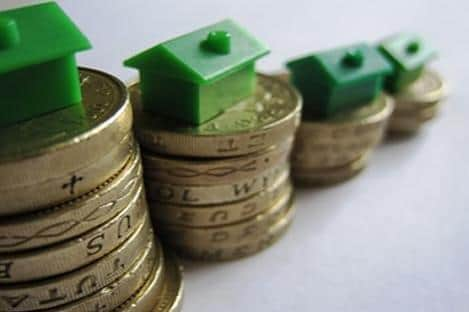The average house price in NI is over £169,000, the highest in 14-years
and live on Freeview channel 276
The average house price in Northern Ireland is over £169,000, the highest level in 14-years and 5.3 times the annual gross full time salary!
The Northern Ireland House Price Index showed that house prices here increased by 3.2% quarter-on-quarter and 9.6% year-on-year.
Advertisement
Hide AdAdvertisement
Hide AdThe latest figures also show that the bigger the house, the bigger the rise, with both detached and semi-detached properties hitting double-digit growth of 10.8 and 10.1% respectively.


This is perhaps unsurprising given the much talked about ‘race for space’ that we have seen since the pandemic began. Meanwhile terraced houses and apartments rose by a more modest 8.4 and 6% respectively.
Ards and North Down (which includes the ‘Gold Coast’) and Mid-Ulster saw the sharpest rises in house prices in Q2, both at 12.1%.
Anecdotally, it seems that the former has benefited from higher income buyers from the South East of England wanting to acquire large homes in this part of the world.
Advertisement
Hide AdAdvertisement
Hide AdThis has helped Ards and North Down regain its place as the most expansive place to buy a home in Northern Ireland from Lisburn & Castlereagh.
On the other hand, Belfast saw the lowest rate of price growth in the year, perhaps linked to the rise in working from home, meaning that there isn’t the same imperative as there used to be to live near where you work.
CPI (consumer price index) inflation for July was 10.1%, its highest rate in over 40 years.
Whilst energy prices have been the dominant factor pushing up the rate of inflation until now, the latest pick-up is related to rising food prices. The rate of inflation for food prices increased to 12.8%, the highest rate in over 20 years. People will already have noticed big increases in the price of their weekly shop, but it’s now official.
Advertisement
Hide AdAdvertisement
Hide AdLow fat milk saw the biggest increase in price at 34%, whilst bread and cereals were up 12.3%, meat was up 13.1 percent and the humble spud was up almost 16%. Outside of food, there were big increases in the price of electricity and gas (54% and 95.7% respectively) and the price of insurance has increased 13.6%. And whilst we have seen petrol and diesel prices come down at the pumps in recent weeks, the latest inflation figures highlight the extent of price rises over the year to July when they up 42.9% and 46.1% respectively.
These are figures across the board on a scale I haven’t seen before. And there’s likely to be little respite in the near future for consumers with the CPI inflation rate expected to continue to increase.
The Bank of England projects that it will rise to 13% by the end of the year and only then will the rate of inflation start to come down, but nowhere near as fast as the Bank of England, businesses and households want it to. When we look at producer prices (or ‘factory gate inflation’) which are perhaps an even more timely indicator, these were rising at 17.1% in July.
This is the highest in 45 years. These figures show the extent of price rises that are still to feed through into the prices consumers pay.
Advertisement
Hide AdAdvertisement
Hide AdThe trajectory of house price inflation is likely to take a difference course.
Since the onset of the pandemic two and a half years ago, house prices in Northern Ireland have risen by more 20%, that’s double the rate of increase seen in the two-and-a-half years before.
Going forward, the rates of house growth will slow significantly for a range of reasons.
The cost-of-living crisis, interest rate hikes, tax rises and declining consumer confidence are all headwinds that the housing market will face in the months and years ahead. T
Advertisement
Hide AdAdvertisement
Hide Adhis is in sharp contrast to the favourable conditions the housing market faced a couple of years ago, when interest rates hit record lows, inflation was almost non-existent and the cost of things like fuel and energy were all falling.
With all of these reversed, the conditions are therefore now in place for house price growth to slow rapidly; and some might say even potentially to go into reverse.
Incomes are set to be squeezed like never before. The one thing that will mitigate against price falls though is the lack of supply to meet demand. This lack of supply was an issue before the pandemic and has become even more of an issue now.
Indeed, these figures showed that housing starts and completions continue to fall.
In summary therefore, whilst the Bank of England has a 2% target for inflation, Northern Ireland house price growth will likely get to this rate long before CPI.